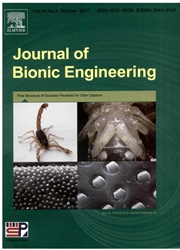

 中文摘要:
中文摘要:
Biomimetic surface is an effective ways to promote the performance grade and applied range of materials without alteringtheir substrate.Many improved properties such as resisting fatigue,enduring wear,etc,have been achieved by applyingbiomimetic morphology or structure to some engineering material surfaces.In this paper,aiming to reveal the relationshipbetween thermal cracking behavior and mechanical properties of engineering materials with biomimetic surface,biomimeticspecimens were fabricated using laser technique by imitating the heterogeneous structure on the surface of plant leaves.Theeffect of thermal fatigue cycling on the tensile properties of H13 die steel specimens with different surfaces (several types ofbiomimetic surfaces and a smooth surface) was compared and investigated.As a result,due to the coupling effects of themorphological features on the surface and the microstructure characteristics within unit zone,these specimens with biomimeticsurface exhibit remarkably enhanced Ultimate Tensile Strength (UTS) and 0.2% Yield Strength (YS) compared with referencespecimens while corresponding ductility remains largely unaffected even heightened,whether the thermal fatigue loads or not.The relative mechanisms leading to these improvements have been discussed.
 英文摘要:
英文摘要:
Biomimetic surface is an effective ways to promote the performance grade and applied range of materials without alteringtheir substrate.Many improved properties such as resisting fatigue,enduring wear,etc,have been achieved by applyingbiomimetic morphology or structure to some engineering material surfaces.In this paper,aiming to reveal the relationshipbetween thermal cracking behavior and mechanical properties of engineering materials with biomimetic surface,biomimeticspecimens were fabricated using laser technique by imitating the heterogeneous structure on the surface of plant leaves.Theeffect of thermal fatigue cycling on the tensile properties of H13 die steel specimens with different surfaces (several types ofbiomimetic surfaces and a smooth surface) was compared and investigated.As a result,due to the coupling effects of themorphological features on the surface and the microstructure characteristics within unit zone,these specimens with biomimeticsurface exhibit remarkably enhanced Ultimate Tensile Strength (UTS) and 0.2% Yield Strength (YS) compared with referencespecimens while corresponding ductility remains largely unaffected even heightened,whether the thermal fatigue loads or not.The relative mechanisms leading to these improvements have been discussed.
 同期刊论文项目
同期刊论文项目
 同项目期刊论文
同项目期刊论文
 Biomimetic Construction of Category Mental Imagery Based on Recognition Mechanism of Visual Cortex o
Biomimetic Construction of Category Mental Imagery Based on Recognition Mechanism of Visual Cortex o Study on preheating and annealing treatments to biomimetic non-smooth cast iron sample with high the
Study on preheating and annealing treatments to biomimetic non-smooth cast iron sample with high the Optimization of Laser Processing Parameters and Their Effecton Penetration Depth and Surface Roughne
Optimization of Laser Processing Parameters and Their Effecton Penetration Depth and Surface Roughne Macro-/Micro-Structures of elytra, mechanical properties of the biomaterial and the coupling strengt
Macro-/Micro-Structures of elytra, mechanical properties of the biomaterial and the coupling strengt Friction and wear property of duplex MAO/CrN coatings sliding against Si3N4 ceramic balls in air, wa
Friction and wear property of duplex MAO/CrN coatings sliding against Si3N4 ceramic balls in air, wa Study on adhesion resistance behavior of sample with striated non-smooth surface by laser processing
Study on adhesion resistance behavior of sample with striated non-smooth surface by laser processing Contact mechanics of pad of grasshopper (Insecta: ORTHOPTERA) by finite element methods. Chinese Sci
Contact mechanics of pad of grasshopper (Insecta: ORTHOPTERA) by finite element methods. Chinese Sci Biomimetic coupling effect of non-smooth mechanical property and microstructural features on thermal
Biomimetic coupling effect of non-smooth mechanical property and microstructural features on thermal Effects of graphite shape on thermal fatigue resistance of cast iron with biomimetic non-smooth surf
Effects of graphite shape on thermal fatigue resistance of cast iron with biomimetic non-smooth surf Effect of medium on friction and wear properties of compacted graphite cast iron processed by biomim
Effect of medium on friction and wear properties of compacted graphite cast iron processed by biomim Effects of pre-placed coating thickness on thermal fatigue resistance of cast iron with biomimetic n
Effects of pre-placed coating thickness on thermal fatigue resistance of cast iron with biomimetic n Biological coupling anti-wear properties of three typical molluscan shells—scapharca subcrenata, rap
Biological coupling anti-wear properties of three typical molluscan shells—scapharca subcrenata, rap Structure and mechanical properties of pincers for lobster (Procambarus clarkii) and crab (Eriocheir
Structure and mechanical properties of pincers for lobster (Procambarus clarkii) and crab (Eriocheir Effect of Cu content in Cu-Ti-B4C system on fabricating TiC/TiB2 particulates locally reinforced ste
Effect of Cu content in Cu-Ti-B4C system on fabricating TiC/TiB2 particulates locally reinforced ste Microstructure, hardness, and thermal fatigue behavior of H21 steel processed by laser surface remel
Microstructure, hardness, and thermal fatigue behavior of H21 steel processed by laser surface remel Effect of biomimetic non-smooth unit morphology on thermal fatigue behavior of H13 hot-work tool ste
Effect of biomimetic non-smooth unit morphology on thermal fatigue behavior of H13 hot-work tool ste Thermal fatigue resistance of H13 steel treated by selective laser surface melting and CrNi alloying
Thermal fatigue resistance of H13 steel treated by selective laser surface melting and CrNi alloying 期刊信息
期刊信息
